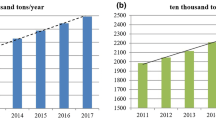Abstract
Research has been conducted at the Faculty of Metallurgy, Technical University, Kosice, to develop a hydrometallurgical method for removing arsenic from copper converter dust. The process consists of a selective leaching of the flue dust in which arsenic is dissolved in sodium-sulfide solution and then removed by precipitation methods using various agents: copper sulfate, a mixture of phosphoric acid with calcium hydroxide, calcium oxide, and ferrous or ferric sulfate. In principle, arsenic can be removed as a marketable product (copper arsenate for wood preservation) or as stable precipitate compounds suitable for safe landfill disposal under existing U.S. Environmental Protection Agency regulations.
Similar content being viewed by others
References
P. Barios and J. A. Suarez, “Control of Atmospheric Contamination in Non-Ferrous Metallurgy,” COST Action 617 Stationary Sources of Urban Air Pollution, ed. J. Moreno-Clavel and J. Moreno-Grau (European Commission EUR 18529 EN, 1998), pp. 73–94.
L. Bobok et al., “Treatment of the Flue Dust” (Kosice, Poland: Faculty of Metallurgy, Technical University, 1991).
M. Tomita et al., “Hydrometallurgical Process of Copper Converter Dust,” Residues and Effluents—Processing and Environmental Considerations, ed. R.G. Reddy, W.P. Imrie, and P.Q. Queneau (Warrendale, PA: TMS, 1991), pp. 283–295.
M. Matsumoto et al., “Treatment of Effluent Waters at Kosaka Smelter and Refinery,” The Paul E. Queneau Int. Symp. Extractive Metallurgy of Copper, Nickel and Cobalt, ed. C.A. Landolt (Warrendale, PA: TMS, 1993), pp. 1599–1612.
R.S. Kunter and W.E. Bedal, “Chloride-Process Treatment of Smelter Flue Dusts,” JOM, 44 (12) (1992), pp. 35–38.
T.X. Ma, “Introduction of Treatment of Arsenic Sulfide Residues in Guixi Smelter,” Jiangxi Copper Engineering, 4 (1990), pp. 32–37.
S.L. Dong, “An Investigation on Hydrometallurgical Processing of Arsenic Sulfide Residues,” Sulfuric Acid Industry, 5 (1994), pp. 3–8.
H. Wang, K. Jiang, and L. Li, “Oxidative Pressure Leaching for Arsenic Sulfide Residues from Gas Cleaning of Copper Smelting,” Proc. Global Conference on Environmental and Metallurgy, ed. Q. Dingfan and Ch. Youyi (Beijing, China: Int. Academic Publishers, 1999), pp. 401–405.
F. Terayama, “Arsenic Recovery and High Purity Arsenic Metal Production from Arsenic Residues of Copper Smelting Process,” Metallurgical Review of MMIJ, 6 (2) (1989), pp. 1–16.
M. Havlik, “Antimony, Nickel and Arsenic During Converting of Copper Matte” (Habilitation Thesis, Technical University, Kosice, October 1997).
Author information
Authors and Affiliations
Additional information
For more information, eontact E. Vircikova, Technical University, Faculty of Metallurgy, Letna 9, 04000 Kosice Slovakia; telephone 421-95-602-2703; fax 421-95-633-7048; e-mail vircik@hfnov.tuke.sk.
Rights and permissions
About this article
Cite this article
Vircikova, E., Havlik, M. Removing as from converter dust by a hydrometallurgical method. JOM 51, 20–23 (1999). https://doi.org/10.1007/s11837-999-0152-1
Issue Date:
DOI: https://doi.org/10.1007/s11837-999-0152-1




